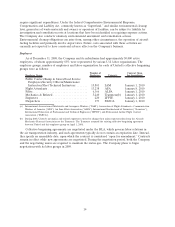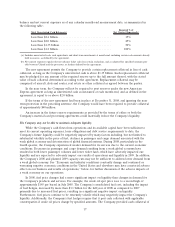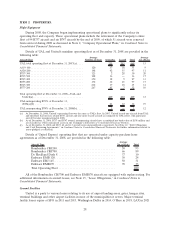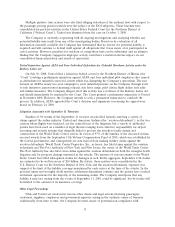United Airlines 2008 Annual Report Download - page 22
Download and view the complete annual report
Please find page 22 of the 2008 United Airlines annual report below. You can navigate through the pages in the report by either clicking on the pages listed below, or by using the keyword search tool below to find specific information within the annual report.The Company’s results of operations fluctuate due to seasonality and other factors associated with the airline
industry.
Due to greater demand for air travel during the summer months, revenues in the airline industry in
the second and third quarters of the year are generally stronger than revenues in the first and fourth
quarters of the year. The Company’s results of operations generally reflect this seasonality, but have also
been impacted by numerous other factors that are not necessarily seasonal including, among others, the
imposition of excise and similar taxes, extreme or severe weather, air traffic control congestion, changes
in the competitive environment due to industry consolidation and other factors and general economic
conditions. As a result, the Company’s quarterly operating results are not necessarily indicative of
operating results for an entire year and historical operating results in a quarterly or annual period are
not necessarily indicative of future operating results.
The Company may never realize the full value of its intangible assets or our long-lived assets causing it to
record impairments that may negatively affect its results of operations.
In accordance with Statement of Financial Accounting Standards No. 142, Goodwill and Other
Intangible Assets (“SFAS 142”) and Statement of Financial Accounting Standards No. 144, Accounting for
the Impairment or Disposal of Long-Lived Assets, (“SFAS 144”), the Company is required to test certain
of its intangible assets for impairment on an annual basis on October 1 of each year, or more frequently
if conditions indicate that an impairment may have occurred. In addition, the Company is required to
test certain of its tangible assets for impairment if conditions indicate that an impairment may have
occurred.
During the second quarter of 2008, the Company performed an interim impairment test of its
goodwill, all indefinite-lived intangible assets and certain of its long-lived assets (principally aircraft and
related spare engines and spare parts) due to events and changes in circumstances that indicated an
impairment might have occurred. Factors deemed by management to have collectively constituted a
potential impairment triggering event included record high fuel prices, significant losses in 2008, a
softening U.S. economy, analyst downgrade of UAL common stock, rating agency changes in outlook for
the Company’s debt instruments from stable to negative, the announcement in 2008 of the planned
removal from UAL’s fleet of 100 aircraft and a significant decrease in the fair value of the Company’s
outstanding equity and debt securities during 2008, including a decline in UAL’s market capitalization to
significantly below book value.
During the fourth quarter of 2008, the Company performed its annual impairment test of intangible
assets and determined that no additional impairment had occurred. In addition, due to certain conditions
similar to those which triggered the second quarter 2008 impairment testing, in the fourth quarter of
2008, the Company tested its B737 and B747 aircraft for additional impairment during the fourth
quarter, including evaluating the fair value of those aircraft already removed from service, which resulted
in additional impairment charges being recorded in the fourth quarter.
As a result of the impairment testing performed in the second and fourth quarters of 2008, the
Company recorded goodwill and tangible and intangible asset impairment charges totaling approximately
$2.6 billion during 2008. The Company determined that goodwill was completely impaired. However, the
Company still has book values at December 31, 2008 of approximately $10.3 billion of operating property
and equipment and $2.7 billion of intangible assets that could be subject to future impairment charges.
We may be required to recognize additional impairments in the future due to, among other factors,
extreme fuel price volatility, tight credit markets, a decline in the fair value of certain tangible or
intangible assets, unfavorable trends in historical or forecasted operating or cash flow losses and the
uncertain economic environment, as well as other uncertainties. The Company can provide no assurance
that a material impairment charge of tangible or intangible assets will not occur in a future period. The
value of our aircraft could be impacted in future periods by changes in the market for these aircraft.
Such changes could result in a greater supply and lower demand for certain aircraft types as other
22
























